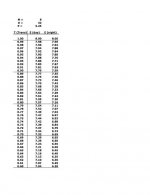Ed,
Thanks for applying the formulas given by Vukobratovich and calculating a nice table.
I had done a couple of points, but its nice to have the whole picture laid out. It is surprising that one bino can be obviously brighter, but actually show practically no more. I can't blame people for choosing the brighter binocular if that's what they prefer, but it is more an aesthetic, than practical, issue. And in very bright light, sunglasses anyone? Just take your personal pick on brightness. It is real bright most of the time here in New Mexico.
I have experienced the things you have plotted, although complicated by magnification differences, with the 83% transmitting 8x42 Trinovid, the 89% 8.5x42 Swarovski EL, and the 95% Fujinon 7x50. It is a lovely thing, going out with binoculars to a beautiful natural spot at sunset and observing until dark, and then at last looking at the stars! I recommend this to everybody just to get in touch with the planet, optics comparisons aside. My official excuse for doing this is "owl spotting", but heck, it's just plain beautiful even with no owls, fortunately, because that is often the case. This kind of observing takes one essentially from day into night.
It is quite obvious to my eyes that in very low light, the 7x50 Fujinon presents the greatest surface brightness of the three, due to both its greater transmission and its 7.1mm exit pupil (my eyes go just over 6mm, so I can appreciate part of it). It has brightness advantages over the Leica of 14% (95/83 = 1.14) for transmission and another whopping 31% for the exit pupil ((6/5.25)**2), with a product of 49% advantage. Even with this, these two binoculars reveal equal detail in low light. The brightness difference is made up by the Leica's 14% greater magnification. So, it appears that at least in this range, magnification is roughly 49/14=3.5x as important as surface brightness.
But the Swarovski beats both! Clearly, compared to the Trinovid, its extra 6% in magnification greatly exceeds its 7% (.89/.93=1.07) transmission advantage in actual visiblity gain, but these effects combine to show a little more detail.
What is funny is that the Fujinon 10x50, which you might expect would slay all, is really no better in very low light than the 8.5x42! More power, better transmission, similar exit pupils, what gives? All I can figure is, 10x is over the line of diminishing hand held return, at least for me. Steadied, however, it is easily the best of the bunch on the sky.
These comparisons are fun, but for all this rant, the differences I'm talking about pale on an absolute scale. Any binocular will reveal so much on the earth near dark, and of the heavens after dark, it's scary.
Ron





